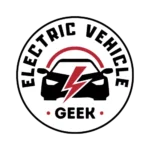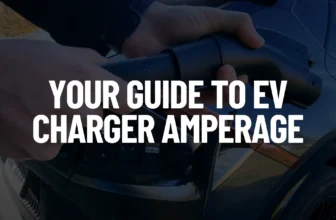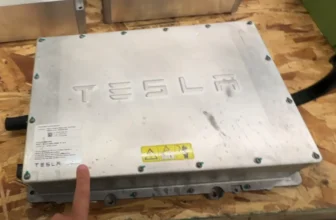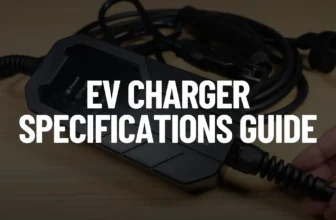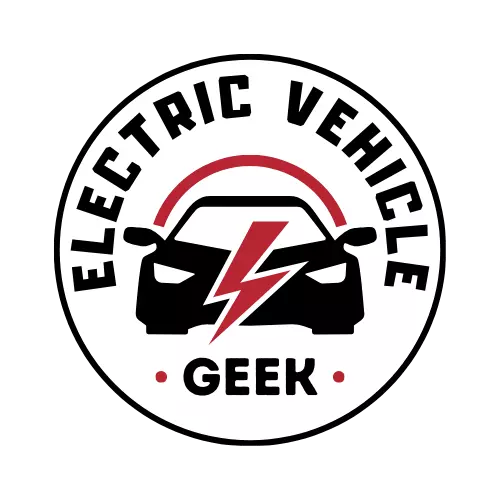When looking for an electric vehicle fire extinguisher, we recommend making sure the fire extinguisher is designed to combat the unique challenges of electric vehicle battery fires.
When facing electric vehicle (EV) battery fires, traditional fire extinguishers often fall short due to the specific characteristics of lithium-ion battery fires. These fires can reignite because standard extinguishing agents do not effectively counter the unique chemical reactions of lithium-ion batteries.
This guide thoroughly explores today’s top electric vehicle fire extinguishers, assessing their effectiveness and safety advantages over traditional options. We delve into their advanced technologies designed to combat EV fires, highlighting their superior capability in managing lithium-ion battery fires and addressing the unique challenges posed by EVs.
Table of Contents
- In a Hurry? We recommend the Amerex Dry Chemical Fire Extinguisher
- What Causes Electric Vehicle Fires?
- Best Electric Vehicle Fire Extinguisher
- Fire Extinguishers to Avoid for Electric Vehicles
- Factors To Consider Before Purchasing An Electric Vehicle Fire Extinguisher
- User-Friendly Design
- How To Use An Electric Vehicle Fire Extinguisher
- Stages Before Using an Electric Vehicle Fire Extinguisher
- What Not To Do When Using an Electric Vehicle Fire Extinguisher
- Conclusions.
In a Hurry? We recommend the Amerex Dry Chemical Fire Extinguisher
We recommend dry chemical extinguishers such as the Amerex dry chemical fire extinguisher, which can help disrupt the chemical reactions fueling the fire, although they are not certified specifically for lithium-ion battery fires, they help by suffocating the flames, due to the thermal runaway of battery cells, they may not prevent re-ignition.
While dry chemical extinguishers are not certified specifically for lithium-ion battery fires, they help by suffocating the flames. However, due to the thermal runaway of battery cells, they may not prevent re-ignition.
What Causes Electric Vehicle Fires?
One major contributor to electric vehicle fires is the degradation of lithium-ion cells due to internal imbalances, worsened by improper charging practices, abuse (mechanical, electrical, or thermal abuse), and natural wear over time.
Lithium-ion battery fires are complex events due to the involvement of several flammable components that make up an as shown in the image below:
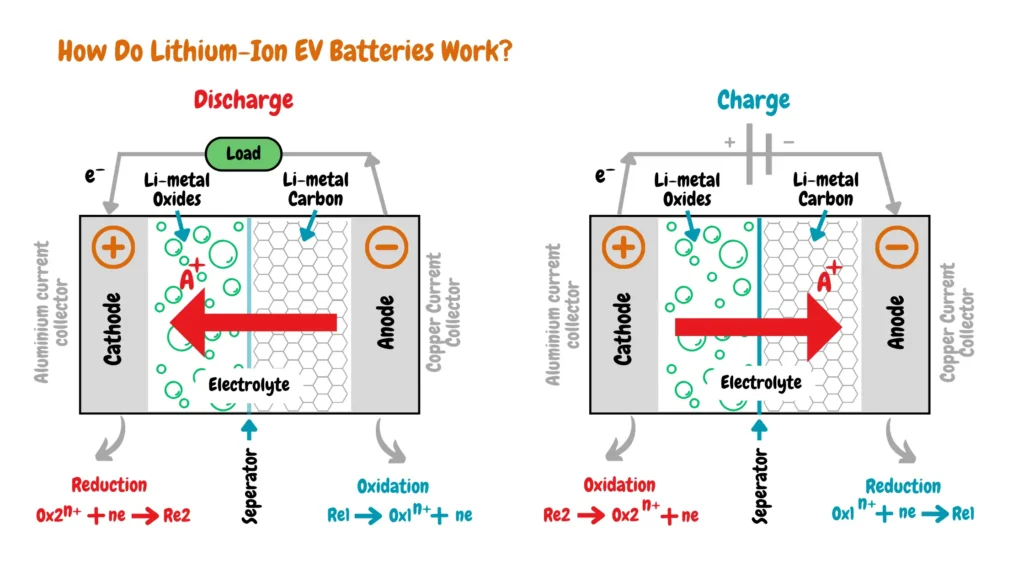
As you can see from the image above lithium-ion battery contains a combustible cocktail: the graphite anode (a flammable solid), the organic electrolyte (a flammable liquid), and trace amounts of lithium metal (a reactive metal). These highly flammable components contribute to the intensity and complexity of battery fires, making them difficult to control and extinguish.
Thermal runaway, another critical issue, occurs when cell overheating triggers uncontrollable reactions within the battery by affecting adjacent cells, which leads to thermal propagation as shown in the illustrative image below.
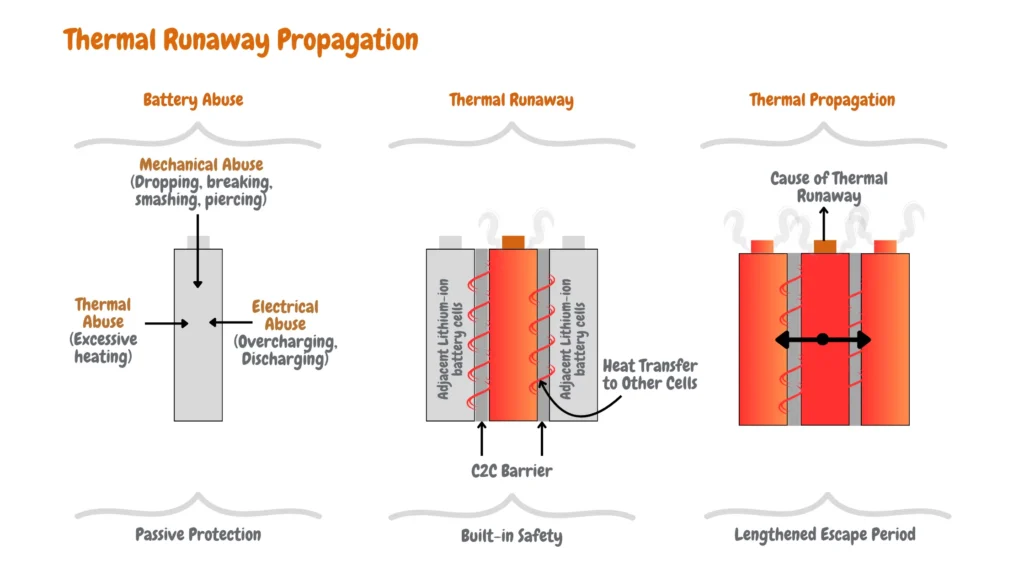
Other Causes of Electric Vehicle Fires
Using incompatible or malfunctioning charging equipment can lead to excessive currents or voltage spikes, which stress the electric vehicle battery and heighten the risk of internal shorts. Likewise, defects in vehicle electrical systems, such as faulty wiring or control units, along with exposure to water, can create conditions that also stress the battery, including electrical shorts and corrosion, thereby contributing to fire hazards.
Best Electric Vehicle Fire Extinguisher
Now that you understand the causes of electric vehicle fires, it’s time we discuss the best electric car fire extinguisher that you can buy to help extinguish electric vehicle fires.
Specialized Lithium-Ion Battery Fire Extinguisher
There are so many fire extinguisher technologies emerging specialized for combating lithium-ion battery fires such as the Lith-Ex fire extinguisher, Lith-Ex extinguishers use a special extinguishing agent called Aqueous Vermiculite Dispersion (AVD) to cool the fire and smother the flames.
AVD is a water-based solution that contains vermiculite, a naturally occurring mineral that expands when heated making it a good solution when it comes to mitigating thermal propagation in a lithium-ion battery, what makes Lith-Ex fire extinguishers a better electric vehicle battery fire extinguisher than traditional fire extinguishers is that they cool the battery with water content and suffocate the fire with a vermiculite layer, the vermiculite layer forms a heat-proof barrier around the burning battery cell to prevent propagation and re-ignition.
While the battery is a significant concern in electric vehicle fires, it’s important to recognize that other electrical issues such as faulty wiring, malfunctions in various components, and external factors can also be contributing factors. This underscores the need for specialized fire extinguishers like the Lith-Ex model, which are designed to effectively combat lithium-ion battery fires.
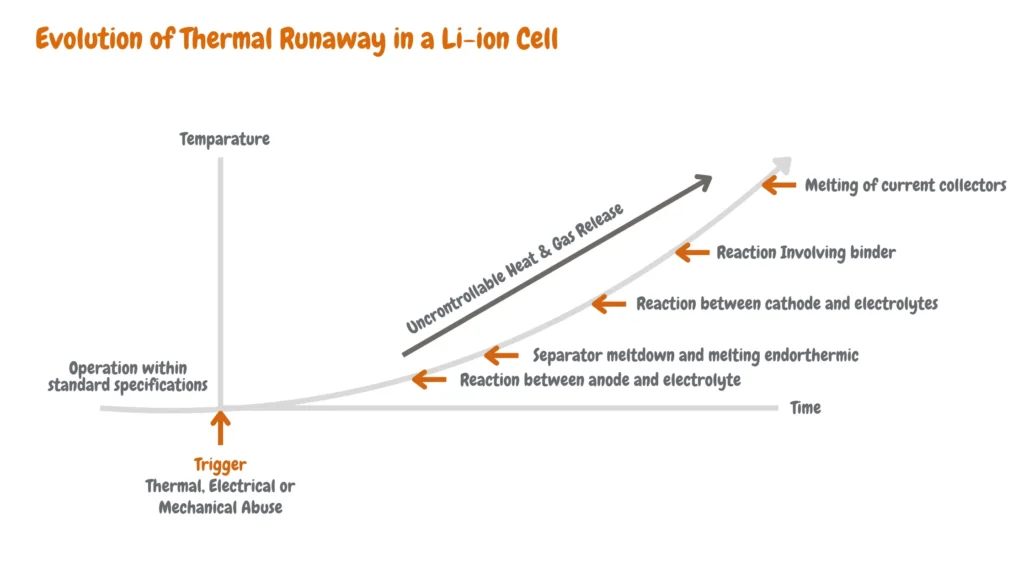
As you can see from the illustrative image above lithium-ion battery fires can propagate rapidly due to toxic gases, and thermal issues and potentially lead to explosions, posing challenges for vehicle owners attempting to extinguish them. Additionally, accessing the battery during a fire incident in an electric vehicle can be particularly challenging. In such cases, we recommend leaving thermal propagated fires to proffesionals.
Studies have also shown that specialized lithium-ion battery fire extinguishers like the Lith-Ex have shown limited effectiveness in suppressing fires due to the unique combustion characteristics of lithium-ion batteries. As a more practical solution, common electric vehicle owners may consider using dry chemical extinguishers, which can serve as general-purpose fire suppressants for electric vehicles.
Dry Chemical Fire Extinguishers
For common electric vehicle owners who don’t have professional training in firefighting or do not directly deal with lithium-ion batteries, we recommend purchasing dry chemical fire extinguishers such as Amerex dry chemical fire extinguishers as a general electric car extinguisher.
The extinguisher contains a fine, talc-like powder made of chemical agents like baking soda. When squeezed, pressurized gas shoots the powder out in a thick cloud, effectively blanketing the fire and starving it of oxygen. However, unlike Lith-Ex fire extinguishers, dry powder extinguishers don’t cool the burning material, so there’s a potential risk of re-ignition if the heat source isn’t addressed after the fire is smothered as shown in the illustrative image below:
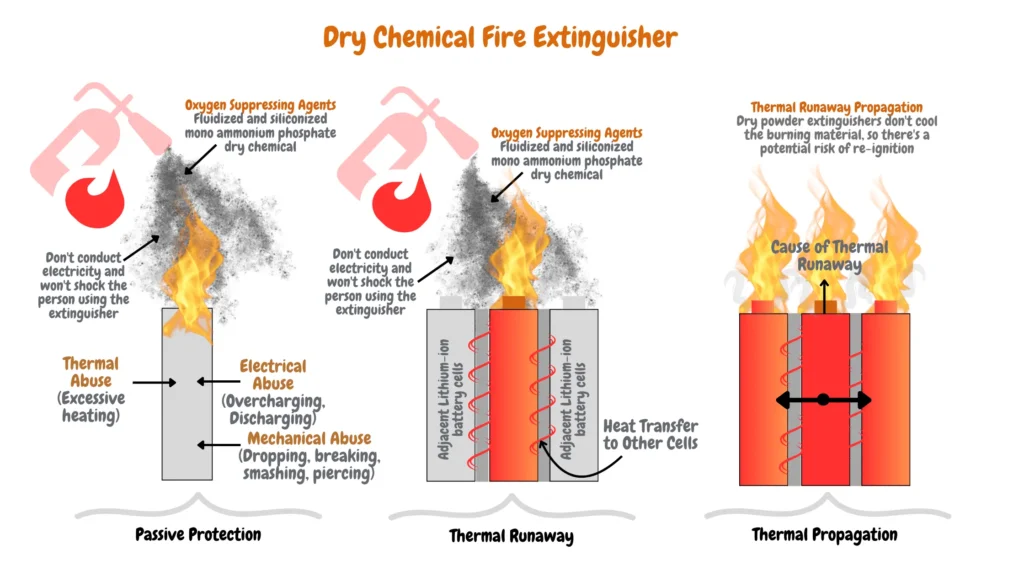
Dry chemical fire extinguishers are suitable for extinguishing electrical fires involving equipment under 1,000 volts, they also don’t conduct electricity and won’t shock the person using the extinguisher, making them an effective choice for combating various types of electric car fires. These include fires related to home EV chargers (caused by incompatible or malfunctioning charging equipment), electric vehicle branch circuits (due to faulty wiring, control unit malfunctions, or exposure to water), and other common causes of electric vehicle fires.
Fire Extinguishers to Avoid for Electric Vehicles
Highlighted below are some of the fire extinguishers we don’t recommend for use to mitigate electric vehicle fires.
Carbon Dioxide Fire Extinguisher
We don’t recommend the use of carbon dioxide fire extinguishers, this is because a burning electric vehicle battery produces flammable gases including oxygen which will reduce the smoothing effects of carbon dioxide.
Foam Fire Extinguisher
We also don’t recommend foam fire extinguishers which work best in containment of hot temperature liquid fires, as we have seen in the causes of electric vehicle fires, the common culprit is the electric vehicle battery, during thermal runaway, the battery produces uncontrollable heat and gases and will destroy the form created the foam fire extinguisher, thus not providing the smothering effect required for containment of electric vehicle fires.
Water Based Fire Extinguisher
We also don’t recommend water-based fire extinguishers use in an electric vehicle because they can be dangerous to the electric vehicle’s electrical system because water conducts electricity, using a water-based fire extinguisher will create a path for electricity to travel increasing the risk of short circuits to the battery management system wiring, and the electric vehicle battery itself.
Water-based fire extinguishers can worsen the situation by speeding up thermal runaway to the thermal propagation stage. The water can react with the battery chemicals intensifying the existing flames but also increasing the risk of electrocution, and potentially causing a violent thermal runaway event with increased flames and toxic gas release.
Factors To Consider Before Purchasing An Electric Vehicle Fire Extinguisher
Electric car fire extinguishers are crucial for handling lithium-ion battery fires, which are common in EVs. They use non-conductive agents to smother fires safely. These extinguishers are compact, portable, and designed for quick deployment during emergencies. Safety is prioritized with rigorous testing to meet electric vehicle fire challenges.
When choosing an electric car fire extinguisher:
Lithium-Ion Battery Compatibility
Look for an extinguisher explicitly rated for lithium-ion battery fires. These fires require a specialized extinguishing agent to effectively smother the flames and cool the battery, preventing thermal runaway.
Non-Conductive Materials
Since electric vehicles have live electrical components, the extinguisher’s body and discharge materials should be non-conductive. This eliminates the risk of electrocution during fire suppression.
Thermal Runaway Prevention
Avoid extinguisher agents that can exacerbate thermal runaway, a dangerous chain reaction within the battery. Lithium-ion battery-specific extinguishers use agents designed to suppress the fire without triggering this escalation.
Compact and Lightweight
For easy storage and maneuverability in a confined space, choose a compact and lightweight extinguisher. Remember, you might need to act quickly and efficiently in an emergency.
Industry-Certified
Look for extinguishers that meet established industry standards for performance and safety. Reputable certifications ensure the extinguisher’s effectiveness in tackling electric vehicle fires.
User-Friendly Design
In the heat of the moment, a simple and intuitive extinguisher design is critical. Choose one with clear instructions and easy-to-operate mechanisms for a swift and effective response.
How To Use An Electric Vehicle Fire Extinguisher
Assess the Situation
Before attempting to extinguish a fire in an electric vehicle:
- Safety Check: Ensure it is safe to use the extinguisher and that you have the correct type for the fire.
- Type of Fire: Identify the fire source (electrical, battery, etc.) and confirm compatibility with the extinguisher type.
Use the PASS Method
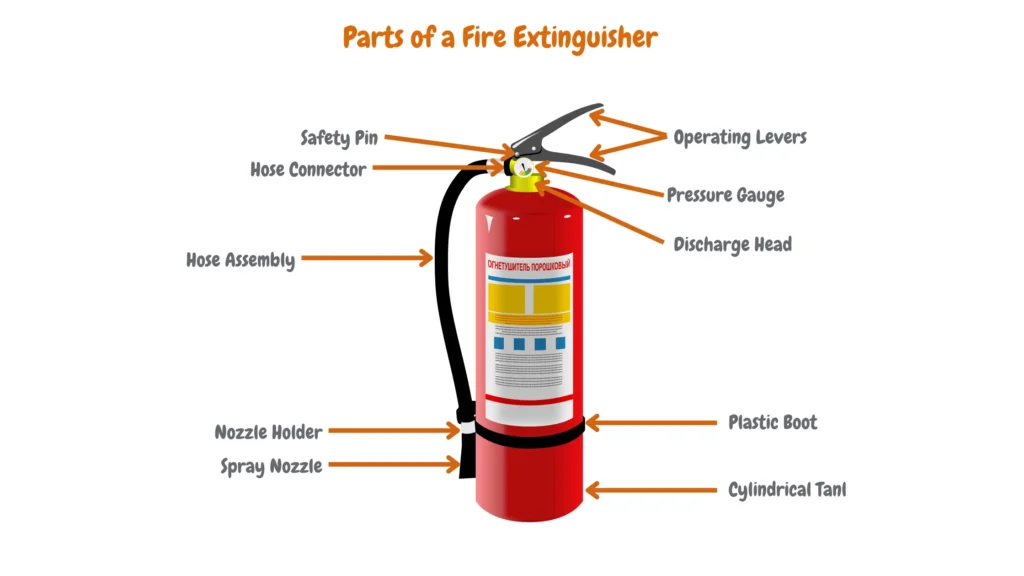
- P – Pull the pin: Remove the safety pin to activate the extinguisher.
- A – Aim the nozzle: Direct the nozzle at the base of the fire, not the flames themselves.
- S – Squeeze the handle: Squeeze the operating levers to release the extinguishing agent.
- S – Sweep from side to side: Sweep the nozzle from side to side until the fire is extinguished.
Monitor the Area
Even after extinguishing the fire, monitor the area to prevent re-ignition due to thermal runaway. Keep a safe distance from the electric vehicle fire at all times. Ensure proper ventilation in enclosed spaces such as garages to prevent accumulation of extinguishing agent fumes.
Stages Before Using an Electric Vehicle Fire Extinguisher
- Prioritize Safety: In the event of an electric vehicle fire, evacuate immediately and ensure everyone maintains a safe distance to avoid toxic fumes and explosions.
- Notify Authorities: Contact emergency services promptly with precise details like fire location, cause of fire, electric vehicle type, and battery type for an effective response.
- Use the Right Extinguisher: If trained and safe, use a recommended electric car fire extinguisher such as a Lith-Ex fire extinguisher or a dry chemical fire extinguisher such as Amerex dry chemical fire extinguishers to control secondary fires without compromising safety near the battery, and avoid using non-recommended fire extinguishers such as carbon dioxide, foam, and water-based fire extinguishers.
- Follow Guidelines: Refer to manufacturer instructions for specific fire handling protocols tailored to your battery type.
What Not To Do When Using an Electric Vehicle Fire Extinguisher
- Do not approach unprotected fires unprepared: Do not attempt to extinguish an electric vehicle fire without proper protective gear and firefighting equipment. Assess the fire’s origin, source, and direction of spread from the battery. It’s advisable to wait for professionals if the source of the fire is the electric vehicle battery because extinguishing electric vehicle battery fires can require large amounts of water (Tesla’s guidance for the Model S specifies approximately 3,000-8,000 gallons) and thermal runaway can persist for up to 72 hours post-extinguishment.
- Do not attempt to reach the battery: Avoid attempting to reach the battery to focus the fire extinguisher compounds on it, the intense heat and toxic fumes emitted by a burning battery can pose a significant health risk, also disrupting the battery casing or protecting features can expose the battery components to air and increase thermal propagation leading to explosions.
- Ignoring the instructions on a fire extinguisher: Ignoring the instructions on a fire extinguisher is a common mistake that can result in improper use and further harm. It’s crucial to carefully read and understand the instructions before use to prevent complications such as short circuits and electrical shocks. Using the correct type of extinguisher is essential for effectively combating electric vehicle fires and avoiding exacerbation of the situation.
- Using the fire extinguisher against the wind: An electric vehicle fire emits numerous flammable and toxic gases from its burning battery. Wind can carry these gases toward you, posing health risks. Additionally, the risk of explosion can cause the fire to spread toward you, making firefighting challenging and increasing the risk of burns.
Conclusions.
Choosing the right fire extinguisher for electric vehicles is crucial for ensuring safety in the event of a fire involving lithium-ion batteries. Given the unique challenges posed by these batteries, such as thermal runaway and the potential for re-ignition, it is clear that specialized extinguishing agents like dry chemical fire extinguishers are most effective. These extinguishers are designed to handle lithium-ion battery fires safely by smothering the flames and cooling the batteries, thereby minimizing the risk of further combustion.
When selecting an electric vehicle fire extinguisher, factors such as lithium-ion battery compatibility, non-conductive materials, and compact, lightweight design should be prioritized. Users must understand how to assess a fire situation, apply the extinguisher correctly using the PASS method, and monitor the area to prevent re-ignition.
Avoiding fire extinguishers like carbon dioxide, foam, and water-based types is advisable due to their limited effectiveness and potential to exacerbate lithium-ion battery fires.
Ultimately, investing in a high-quality, industry-certified fire extinguisher specifically designed for electric vehicles can significantly enhance safety during emergencies, providing peace of mind to drivers and passengers alike. By following recommended guidelines and understanding the unique properties of lithium-ion batteries, users can be better prepared to respond effectively and safely in the event of an electric vehicle fire.

James Ndungu is a certified EV charger installer with over five years of experience in EVSE selection, permitting, and installation. He holds advanced credentials, including certification from the Electric Vehicle Infrastructure Training Program (EVITP) and specialized training in EV charging equipment and installation, as well as diplomas in EV Technology and Engineering Fundamentals of EVs. Since 2021, James has tested dozens of EV chargers and accessories, sharing expert insights into the latest EV charging technologies.
Last update on 2025-12-27 / Affiliate links / Images from Amazon Product Advertising API
